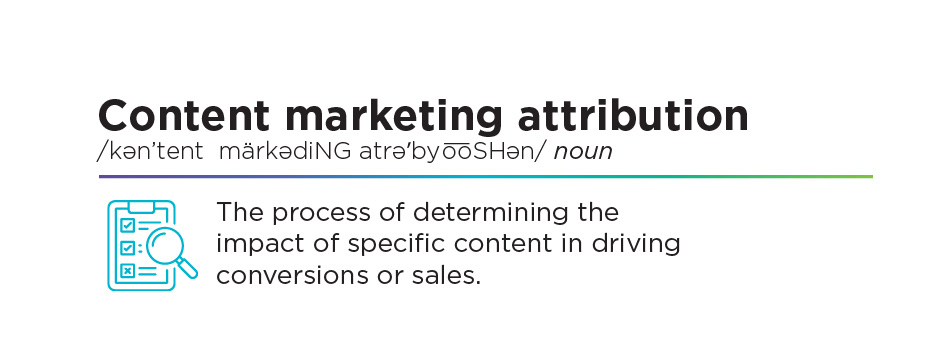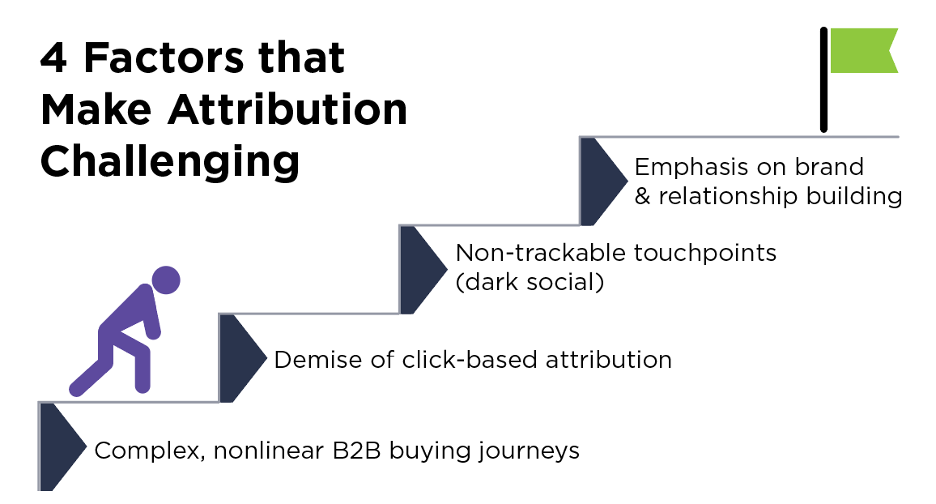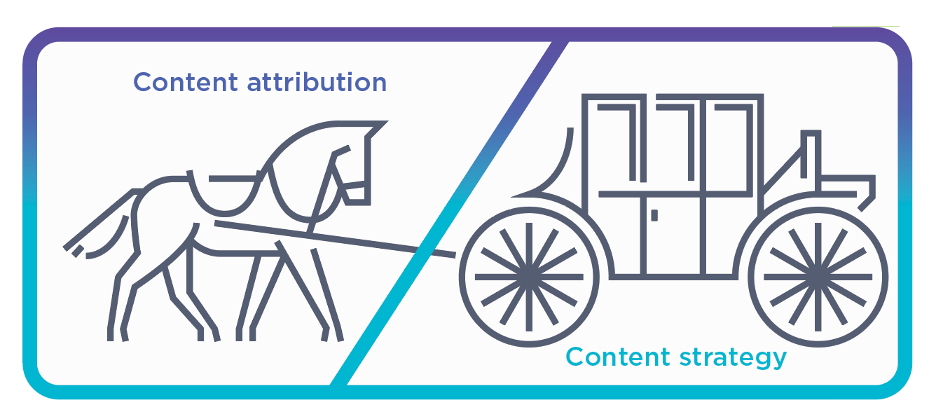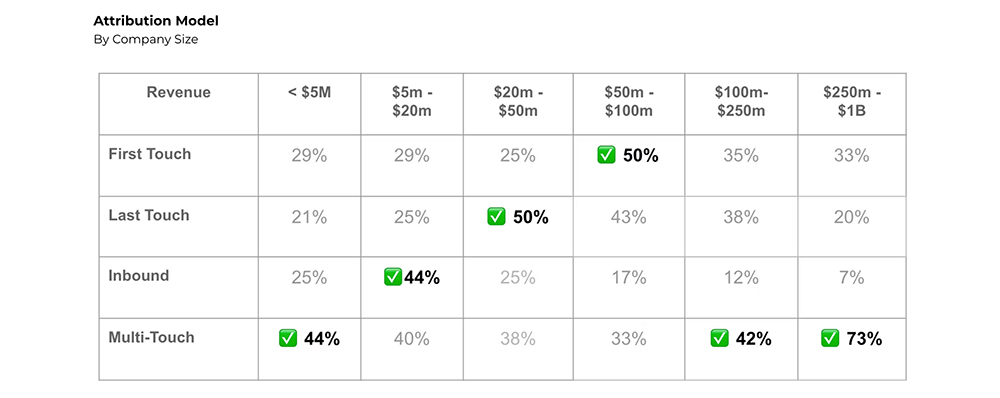Article Guide
- What Is Content Attribution?
- Why Content Attribution is More Challenging Now
- Common Attribution Mistakes
- Why Content Attribution Matters More Than Ever
- 5 Guidelines to Evolve Your Content Attribution Approach
- Evolve Your Approach to Content Performance
Every day your LinkedIn feed serves up a fresh batch of marketing rants, takedowns, and mini-manifestos. Lots of topics get B2B marketers worked up. But the whole “marketing attribution is broken” debate is on another level.
In 2025 the intensity persists, even as the conversation evolves. Content attribution, as a subset of marketing attribution, now sits at the heart of the matter, since content powers B2B marketing more than ever.
It’s time for an honest look at the state of the debate, and what it means for enterprise marketers, specifically. Another thing we need to come to grips with: All the attribution critiques feed an increasing sense of paralysis. If how we measure what’s working isn’t itself working, then what? We need more clarity on how to move forward.

“I don’t share that level of pessimism,” says Lindy Roux, EVP and partner at Tendo. “Is content attribution more challenging as buyer behaviors evolve? Are there lots of potential mistakes to avoid? 100%. But we’re figuring it out. We’re getting better at attribution over time, and putting in the effort is absolutely worthwhile.”
Drew Smith, the CEO of Attributa, a marketing attribution consultancy, and host of the Attribution Nation Podcast, agrees.
“I don’t think attribution is broken. I think what’s happened is people have used it in ways that it’s not designed to be used,” he says. “If you try to use a hammer to saw a piece of wood, it’s not going to work very well. So, people need to understand what attribution does really well and what it doesn’t do well.”
Aligning on a Definition: What Is Content Attribution?
Before we get too far into the debate details, let’s level-set on the meaning and purpose of content attribution. We like this simple definition from Letterdrop:

The purpose of content attribution can be distilled into two priorities:
- To gain actionable insights on what content is working and what isn’t, so you can optimize your strategy to be more effective.
- To demonstrate the ROI of content marketing activities to executives, usually to win or defend budget (and your job).
Why Content Attribution Is More Challenging Now
Traditional marketing attribution is harder to get right in 2025. Here’s why:
- Complex, nonlinear B2B buying journeys: Journeys are getting longer and more complex, with more touchpoints across multiple channels and larger buying committees participating in the decision. It’s more difficult to track their behaviors and content preferences and then attribute them to revenue. Simplistic attribution models can give flawed results—that a single piece of content is responsible for a close-won deal, for example.
“We can’t treat marketing like a gumball machine,” writes Jon Miller. “Put a quarter in, get an MQL out. There’s no way to do attribution and say, ‘this deal happened because I did this one thing.’”
- Demise of click-based attribution: So often, content attribution is based on who clicked what, but today, fewer people are clicking anything. AI is replacing search, LinkedIn’s algorithm wants to keep you on LinkedIn, and changes to cookies and anti-tracking privacy laws make tracking clicks and behavior more difficult.
- Non-trackable touchpoints: Major buying decisions happen through dark social and other channels and touchpoints that can’t be easily tracked. Buyers do far more research and decision-making on their own before they ever contact sales or are entered into the CRM as an opportunity. In this reality, content attribution models may give a flawed and incomplete picture about what’s actually influencing buyers.
- Greater emphasis on brand/relationship building: B2B marketers more clearly recognize the importance of brand building in tandem with demand generation. The brands that build trust and affinity—long before prospects are ready to buy—are the ones that win (Gong is a stellar example). But traditional attribution models don’t work well to report on the impact and ROI of these activities, which often take much longer to bear fruit.

Common Attribution Mistakes: Stop Doing These Things
Other critiques of content attribution focus on how all-too-common mistakes derail success:
- Fighting for credit: Attribution commonly devolves into a fight about who gets credit for a deal (marketing vs. sales). Teams argue over data quality and how factors should be weighted, at the expense of staying focused on the fundamental purpose of attribution: to deliver actionable insights about what’s working and what’s not, so you can optimize content strategy.
- Over-rotating on attribution: Marketers fixate on easily trackable metrics to “prove” ROI. This tendency pushes them to focus their content strategy on things that deliver these measurable results, rather than activities that meaningfully influence the customer journey. For example, pushing too much gated content for lead gen, simply because it’s easy to track and the metrics look good (even when those leads fail to convert).
Putting the Cart Before the Horse?

- Fragmented measurement, incomplete visibility: Multiple enterprise teams all produce their own content, from brand to demand to product marketing. They may not track content performance consistently or share data.
“Many organizations focus on the short-term only. Teams own one piece of the journey and that’s what they focus on,” says Roux. “They track individual campaign performance, but not how it connects to other activities. In B2B buying, a singular campaign won’t influence an entire buying committee over a 12-month period to get to an actual sale. A win requires brand content, thought leadership, white papers, case studies. But many organizations can’t generate a holistic view of what’s working across the full customer journey.”
- Applying the wrong attribution model: Organizations may apply the wrong attribution model, or one that’s too simplistic for their needs. For example, large B2B enterprises cannot rely on first-touch or last-touch attribution, especially for content. Buyer journeys are too complex to give credit to a single content asset or touchpoint. Multi-touch attribution provides more accurate insights for in-market buyers, but it doesn’t work as well to assess content for brand building.

- Bad data or biased data: Garbage in, garbage out, as they say. If your attribution model incorporates flawed or biased data—over-weighting the importance of certain touchpoints or actions—your analysis will point you in the wrong direction.
Sanity Check: Why Content Attribution Matters More Than Ever
These critiques can leave a marketer deflated, paralyzed. Should you just throw up your hands? Of course not. Flying blind or running on instinct isn’t an option, for some very good reasons:
- C-suite focus on ROI: In the era of revenue marketing, CMOs are on the hot seat to show results and connect activities directly to revenue, especially as many marketing tactics get more expensive, like digital advertising and PPC.
- Greater competition: B2B markets are often crowded with multiple organizations competing for buyer attention and saturating digital spaces with content. It’s much harder to stand out and capture attention in 2025. Understanding what works and what doesn’t is imperative to rise above the chatter.
- Need to optimize investments: Only with clear insights into performance and content ROI can marketers double down on winning content and channels, address weaknesses, properly allocate budgets, and reduce wasteful spend. Imagine discovering that 75% of your content is never consumed by prospects that end up buying; you’d want to fix that pronto.
- Customer journey insights: Analyzing attribution and content performance also gives us invaluable insights into complex B2B customer journeys. To win at marketing, we need a deeper understanding of buyer behaviors and the end-to-end content experience that we’re creating—how multiple touchpoints and pieces of content work together.
5 Guidelines to Evolve Your Content Attribution Approach
The dialogue on attribution swings from “it just doesn’t work” to “here’s the new silver bullet.” Let’s take a breather and step back for a minute. Whether your organization is still using first-touch attribution or considering advanced marketing mix modeling, these guidelines can help you gain perspective on how to adapt and evolve.
1. Define your key questions.
“List out the questions that you want marketing attribution to answer for you,” suggests Smith. “Asking the right questions up front can help focus and simplify your attribution approach.”
This exercise can help you determine what attribution models, structured data, and martech tools you need to answer those questions. For example:
- Which content assets increase conversion to pipeline?
- What content is consumed by accounts that end up buying?
- How many content assets did a lead or buying group consume before a closed-won deal?
- Which content topics and types generating the most engagement with our ICP?
- Which content campaigns deliver the best brand lift?
- What percentage of organic traffic turns into deals and wins?
2. Shift to a content experience mindset.
“Approach attribution with the recognition that multiple pieces of content must work together to create a content experience that influences B2B buyers—across multiple touchpoints and channels, and over an extended period, from months to years,” explains Roux.
When you adopt a content experience mindset, you’ll pivot from tracking only the performance and ROI of individual campaigns and assets—and obsessing over which touchpoint gets “credit” for a sale. You’ll also be compelled to understand the end-to-end customer journey and content’s role throughout it. Your investigation will inspire more useful questions to ask and answer:
- What content are prospects engaging with right before a deal is closed, versus at the consideration stage?
- Where in the journey do people want webinars or white papers? (It might not be the stage you assumed.)
- At what point in the journey do we typically lose members of the buying committee? What content helps re-engage them?
It’s certainly no cakewalk to answer these questions and piece together these complex journeys. This effort asks more of your CRM and analytics platforms at a minimum, and exploration of attribution-specific platforms like DreamData or Adobe Marketo Measure.
Tendo’s Lindy Roux Talks Attribution and Content Experience
3. Modify your attribution approach for brand vs demand.
Using the same attribution model across the entire customer journey is a recipe for failure. This is one of Chris Walker’s most impassioned talking points: “We need to look at the customer life cycle in stages and create purpose-built measurement models for each part of [it],” explained Walker on a recent podcast episode.
The argument makes sense when you consider that content simply has too many different roles and objectives at different journey stages—building brand awareness, educating in-market buyers, strengthening customer loyalty—to evaluate its impact the same way.
To start, separate content attribution for brand marketing versus demand generation and capture. For demand capture and tracking in-market buyers, multi-touch attribution (MTA) can help you analyze which content and channels directly influenced deals and revenue.
The brand side may require more diverse attribution and measurement approaches. MTA still works when you can track individual content engagement from the awareness stage through to opportunity, even if it takes years. But what about unowned channels where you can’t get that visibility? And how can you evaluate the performance of channels and content in building relationships and brand trust, and then correlate those brand-building efforts with pipeline and revenue over the long-term?
You can explore different options, like brand lift studies to reveal which channels and campaigns are resonating, and analysis of which ones are associated with buyers shifting from being out-of-market to in-market. At a macro level you can conduct longer-term studies to show how brand building efforts impact factors like customer acquisition cost, deal velocity, and deal size.
4. Explore ways to combine attribution models with other approaches.
Large organizations with more mature marketing operations are combining approaches to give them a fuller picture of what’s working, at both micro and macro levels. Funnel.io, the data platform vendor, advocates for triangulation: using a combination of multi-touch attribution, marketing mix modeling (MMM, sometimes known as “media mix modeling”) and incrementality testing.
MMM and incrementality testing aren’t new, but they’re getting more attention in 2025. MMM uses statistical analysis of aggregate data to look at the “mix” of marketing channels and sales activities and then “model” their effectiveness and forecast their influence on sales. MMM can help guide budget allocations, like how much to invest in organic social media versus paid ads.
Incrementality testing is a controlled experiment in which you evaluate the specific contribution of a marketing initiative by comparing the group that is exposed to it versus a control group that was not. In this way, you can determine its “incremental revenue” contribution.
5. Balance data analysis with qualitative customer research.
Quantitative data is essential for making the right content decisions, but it shouldn’t be your single source of truth. To develop audience-focused content that builds brand affinity and drives revenue, you need both quantitative and qualitative insights. That includes deep, human-centered customer research gleaned from direct customer interviews, sales call transcripts, survey data, and regularly updated personas.
Even beyond your target audience’s pain points and business priorities, you want to learn more about the communities where they congregate, the events they attend, the sources of information they trust, how they prefer to buy, and more.
Syetta Spencer, a revenue marketing analytics leader at Cisco, spoke on a recent episode of the Attribution Nation podcast, and shared her perspective on the need to incorporate customer insights and empathy into her attribution approach:
“I go back to empathy, putting myself in the shoes of a company that wants to purchase from us and thinking through what it’s going to take to really close that deal,” she says. “These journeys are going to be longer. They’re going to include more people. They’re not going to look like we expect them to look. And I [go into] my journey and pathway analysis with these things in mind.”
Content Attribution Will Never Be Perfect
As a marketing leader, you’re always looking for better ways to evaluate content performance and content ROI. But just remember: No attribution model is perfect, no data set is sparkling clean. And that’s OK.
Your goal is to develop an approach that’s good enough to give you actionable insights that lead to better content decisions and better business results.
Evolve Your Approach to Content Performance with Help from Tendo
Is your B2B content underperforming? Don’t just guess at the reasons why. Adopt more sophisticated ways to measure and optimize content performance with help from Tendo. Our content performance services include proprietary methodologies honed by working with world-class B2B brands:
- Content audit and scorecard, to evaluate your content’s strengths and weaknesses, both quantitatively and qualitatively.
- Content measurement frameworks, to track content KPIs tailored to your marketing goals.
- Content experience reviews, for detailed content analysis of key web pages to identify gaps and improve user engagement.
- Content gap analysis, to identify overlooked audiences, journey stages, and content types.









